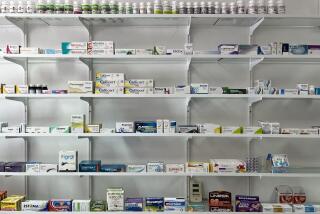Common Sense Is the First Defense Against Home Poisonings
- Share via
Most people think of their home as a haven, but that’s not true when it comes to poisons. Of the 5 million poison exposures that are reported every year in the United States, 90% occur in the home. These involve not only poisons that are swallowed, but also those toxic to the skin and eyes.
The most common agents in home poisonings include cleaning products, medications, cosmetics and personal-care products, pesticides, vitamins, arts and crafts supplies, chemicals and alcohol.
Poisoning prevention begins with common sense. Keep all potential poisons in their original containers with their original labels intact. Read and carefully follow the label instructions on every potentially poisonous product (for example, some products require that you wear protective clothing or eye protection when using them).
Store household products or toxic substances far away from food, and never store potential poisons in used food containers (storing turpentine in an old apple juice jug, for example, is an invitation to disaster). Discard outdated products, as well as any products you don’t anticipate using again. Toxic substances should not be discarded with regular household garbage. Instead, contact Los Angeles County’s environmental information hotline ([888] 253-2652) for guidelines on how to dispose of hazardous waste.
*
Young children have the greatest risk for accidental poisoning, because they are naturally curious and will put much of what they can reach into their mouths. Store potential poisons out of sight and out of reach of children, including kids who may be visiting your home.
Household detergent and other cleaning products should be stored in cabinets above the level of the kitchen counter top, not under the kitchen sink. To protect older children who may be able to reach these higher storage locations, all cabinets containing poisons should be secured with a lock or safety latch.
Medications pose a special hazard for children. Doses considered routine in adults may be life-threatening in children. Medications should always be stored in child-resistant containers, which are much more difficult for small children to open. Be aware, however, that “child resistant” does not mean childproof, so all medications should be kept in locked cabinets. (Most bathroom medicine cabinets are easily accessible, even to young children.)
Take similar precautions with nonprescription drugs. Some over-the-counter products--aspirin, for example--can be lethal in children if they consume extremely large amounts. Even nutritional supplements can be toxic when consumed in excessive amounts. Every year, several children die of iron poisoning after consuming large amounts of vitamins left out by parents who did not understand the danger.
More than 30% of all accidental drug poisonings in children involve medication belonging to someone other than the child’s immediate family. If you have young children in your home, ask your house guests not to leave their medications on counters or in purses or bags that children can reach.
When visiting other people’s homes with your young children, don’t let them roam around until you have checked the surroundings and are sure they are safe. Grandparents’ homes are no exception. The elderly are more likely to take medications and less likely to use childproof containers, which can be difficult for them to open.
*
If, despite your precautions, a poisoning occurs, here are the steps to follow:
* If the victim is unconscious, having seizures or experiencing difficulty breathing, call 911 immediately. Otherwise, if the poisoning involved a medication, contact the Poison Control Center as soon as possible (it is available 24 hours a day, seven days a week).
* Be prepared to answer the following questions: What is the condition of the individual who was exposed? What is the name of the medication, and how much was ingested? When did the exposure occur? What is the person’s age, and how much does he or she weigh?
* Unless you are instructed to do so, do not give anything by mouth. The Poison Control Center can provide you with immediate recommendations for treatment.
* If the poison exposure involves a household product or chemical, you should administer the emergency first aid described below and then call Poison Control. (If more than one adult is available to help, one should call Poison Control while the other provides first aid.)
* When poisonous gases or fumes are the source of the problem, quickly remove the person from the contaminated area and into fresh air as soon as possible. If the gas or fumes present an immediate threat to you, do not attempt to rescue the individual; call 911.
* If the poison comes in contact with the skin, remove any contaminated clothing and then rinse the skin with water continuously for 15 minutes. If the eye is involved, rinse the eye with lukewarm water immediately and continue for 15 minutes. Rather than forcing the eye open to rinse it, encourage the person to blink as much as possible.
* When a household product or chemical is ingested, give a glass of water (2 to 8 ounces) to drink. Do not try to make the person throw up unless instructed to do so by the Poison Control Center. In some cases, vomiting can actually cause additional damage. When it is necessary to induce vomiting, however, syrup of ipecac should be administered. Keep a bottle in the house (stored safely, of course) in case it is needed.
For poison-control information, call the statewide, toll-free telephone line: (800) 876-4766.
*
Dr. Jonathan Fielding is the director of public health and the health officer for the Los Angeles County Department of Health Services. Dr. Valerie Ulene is a board-certified specialist in preventive medicine practicing in Los Angeles. Their column runs the second and fourth Mondays of every month. They can be reached at ourhealth@dhs.co.la.ca.us.


